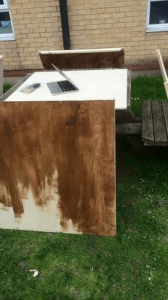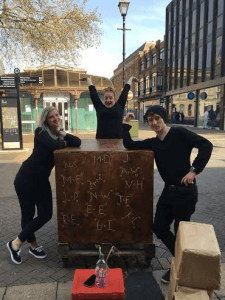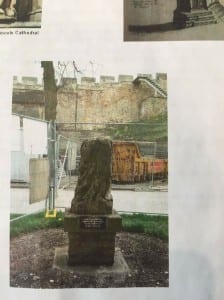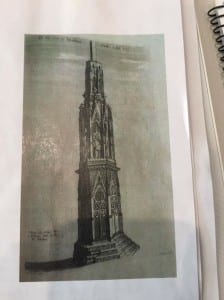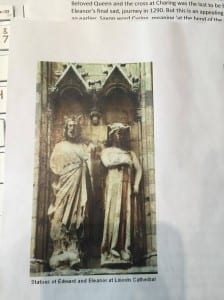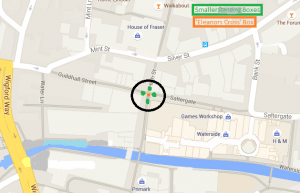FRAMING STATEMENT
My piece was titled Eleanor and Edward, 1254. Our performance was founded through the use of historical content to create a physical journey, which an emotion or feeling (Love) is transported and revealed. This performance has been made immortal due to the recreation of ‘Eleanor’s Crosses’ and other mediums. The idea for our piece was based around the theme and emotion of Love and its representation within Lincoln in modern day and the 13th Century. The reasoning for the title of our piece is based on the sentimental love story of Edward I and his wife Eleanor.
As well as this influence we were inspired by many other practitioners such as Mark Augé and his theory of place and non-place and Deirdre Heddon’s practice in using personal experiences and others experiences to create he work. For this module our group’s site was Lincoln high street and our performance date was the 5th May, 2016 and began at 4pm until 4:45pm on the same day.
OUR PERFORMANCE
Our performance began with my group and I creating a procession from where the high street meets Speakers Corner to just before the Stone bow Archways whilst transporting a 90 x 90 wooden box. As we made our final step in the procession we placed the large wooden box in the centre of the performance area. We all then collected a smaller box to stand on and placed ourselves as if the large box was cross section in our man made cross. We then took to our individual roles as ‘Town Crier’s’. In turns we would declare three of the 18 villages to the audience and the members of the public before then stepping off the smaller boxes and proceeding to the large box. We would then start carving names, initials and dates of the researched couples we had found. Whilst one member of the group was carving the remaining three were declaring in more depth the stories behind the initials. This was performed in a true town crier style. At the time of another group member beginning to carve in to the box the three members stood on boxes held up their cards as if to signal a new stage of the journey.
Once every one of our group’s members had carved for a total of 4-5 minutes we all raised our cards again to signify yet another stage. We all then gathered our smaller boxes and created an outward facing box with our backs touching the larger box. We then in the same order as the carving we all called out the title of our piece,’ Eleanor and Edward, 1254’. This was the signal for our group to all then step off our boxes and begin to carve together. This was intended to act as a closing curtain for the invited audience and members of the public as there was no more performing just visual instillation.
The audience for our performance were invited to the procession to become an active role within our piece. Yet the only interaction we were granted during the performance was if they audience Members began asking questions about our performance or the overall project. Further audience interaction came in when we stepped of our smaller boxes and began a relaxed styled, in depth speaking that was directed to members of the audience. The repetitive movement from on the boxes to off the boxes symbolised to the audience us as ‘town criers’ coming out of that specific role and becoming a less traditional town crier
ANALYSIS OF PROCESS
The thought that anywhere can have the credentials to become a performance space sent my mind reeling. The process of making our performance took some time due to minor disputes over the initial idea and what the best direction would be for our group. Due to the broad boundaries of what site specific performance is, finding the right form to incorporate all of our individual ideas was the most challenging aspect. By the 3rd week session we had gathered our thoughts, had three pre-session meetings and established the theme for our piece. We had decided that the performance base was going to of an emotion that everyone has witnessed or experienced themselves, Love and Romance.
This aspect of incorporating emotion and Lincoln City brought us to the realisation of our first influence. Mark Augé a practitioner within the site specific field whose theory distinguished the question of what makes a place, a place. In his book “Non-places: Introduction to an Anthropology of Super Modernity” he explains the framework behind his theory. “Clearly the word ‘non-place’ designates two complementary but distinct realities: spaces formed in relation to certain ends (transport, transit, commerce, leisure), and the relations that individuals have with these spaces…” (Escdotdot and Sanderson, 2006) To summarise his book he says that we spend a large amount of our lives in side supermarkets, airports, on motorways and hotels. These areas don’t deserve the gratification of being classed as ‘places’. He does clarify these areas but as places of transit. His theory was applied within our performance to justify our site. In relation to his theory our site would be classified as a place of transit, as the middle of high street is a place that people walk through to get to another place. It is not a social space for people to create memories. Unlike a restaurant or the home of each individual. For us to create a performance that people of the public stopped to view it, we created a place. For us it will now be remembered as the place that we performed our site specific performance, but also the emotion both my group members felt and the public felt for watching our piece. This feeling of emotion experienced gives a site the gratification of a place. Being it has now become somewhere that a group of people have experienced a feeling and created a memory. The same thing we realised it was a very common experience that many had shared.
From the very beginning of this process I was certain that I wanted to include a very large visual installation within our piece. This idea was invited into the group as another group member insisted that she also wanted the same style. Because our performance was based on love we wanted to make a loose connection between us the performers and the audience. I was enticed with Deirdre Heddons autobiographical pieces. I decided to research into Heddon’s work to gather inspiration for our piece. Her use of personal experiences and meshing them together with others experiences really connected with our piece. In a book written by Heddon “Autobiography and Performance” a brief over view of the way she handles her workings. “ Heddons engaging style seamlessly blends the theoretical and personal, pursing proactive question around issues of ‘truth’, identity, personal history and political agency, confession, voyeurism and ethics.”(Heddon, no date) Heddon’s inspiration broadened our views as a group to what we could use as a connection between ourselves and the audience. We decided to use the large box as a carving stand. We all remembered when we were in secondary school, in our first relationships. This led us to the carving instillation of our piece. When we were younger, carving both the initials into a wooden surface was a way to express the immortality that our love represented. When asking older generations of the public whether they had also done the same thing, we realised it was a very common experience that many had shared.
During the weeks building up to the performance as a group and individually we had gathered research into couple of the general public within Lincoln and couples we knew from all over the U.K. some of these stories we gathered were very detailed about the couple, exactly were they met, how old they were, what their favourite place to go together was. Each week as a group we would take the same journey (from our starting position to the end site) together collecting further couples details that would soon be engraved upon our box. We were introduced in the 5th week’s session to another site specific practitioner. Sophie Calle. This woman’s work focussed particularly into human venerability, intimacy and identity. One of Calle’s performances, Suit Venitienne, 1979 gives a clear understanding of her work. It looks into the tacit agreements within society (boundaries that aren’t discussed but expected to be followed, e.g. when someone falls over you don’t laugh you just keep walking.) And were the boundaries can be. For this piece she followed a stranger known as ‘Henri.B’ from Paris to Venice. She disguised herself and followed his every move gathering photographic and written evidence of him. The intimate connection both our pieces shared was the repetitive journey along with the photographic and written evidence. Although our performance didn’t go to the extremes she did with her one participant we applied the same theory to our featuring couple. King Edward I and his wife Eleanor. The couple had made a trip together from their home in London to the City of Lincoln. They sought rest in 18 different villages until they finally got to their destination. As the pair arrived together Eleanor fell sick, thus resulting in her death. Whilst Edward was grieving for his recently deceased wife, he ordered for 18 ‘Eleanor Crosses’ to be erected in the centre of all 18 villages. This was a token of his never ending love for his queen, as a memorial for the villagers to remember her but most importantly the last journey they took together. The journey this besotted couple took together was full of deep, loving emotion with intention. The intentional journey connected to our performance and our influence as all journeys had intention for either emotion, information or in our case both.
PICTURE OF ELEANORS CROSS
During my research I decided to look for influence from a difference source. Frantic Assembly, a theatre company that has perfected the art of using visual instillation and movement. With the pure intention to make their audience feel a deep connection through emotion towards their piece. A specific project the company successfully executed that reached out to me in relation to my performance was ‘LoveSong’. (Petsas, no date) The writer Abi Morgan created this piece based on a couple in their 20’s and their relationship. “Lovesong intertwines a couple in their 20’s with the same man and woman a lifetime later. Their past and present selves collide in this haunting and beautiful tale of togetherness. All relationships have their ups and downs; the optimism of youth becomes the wisdom of experience. Love is a leap of faith.” (Petsas, no date) This synopsis of the performance is a true explanation of just what the piece involves. The company’s use of silent physical theatre and a disturbing set creates a contradicting atmosphere for the audience. This mirrors our performance due to our use of the procession the harsh reality of life and how relationships can have their darker times. Yet our overall theme for the performance is about the beauty within life through the medium of love.
John Whalley and Lee Miller a husband and wife duo that shared a love for performance. They lived in two separate areas which entailed each meeting having a commute along the M5 motorway. As they travelled alternately the conversation between the two developed to mention how many bottles of urine were scattered along the hard shoulder. This sparked a thought between the pair to create a performance, “Partly Cloudy, Chance of Rain”. The pair’s performance consisted of them driving along ‘their motorway’ and replace every bottle of urine they found and replaced them with an object. We were going to include the giving to receive portion of their performance, however we soon realised that it wouldn’t fit within our piece. This was not the end of the influence our group took from this couple. They then perused a different style and used Augé’s theory within their personal life. Whalley and Miller renewed their vows within a Service station. Augé would have classes the service station as a non-place yet for anyone who was there to witness the renewal of vows would now class that as more than just a service station. Because of the emotion and performance witnessed and experienced there. This related to our performance as we had used the same emotion to create the same effect within a non-place.
PERFORMANCE EVALUATION
On the final performance day we delivered a performance that succeeded in everything we set out to do. There was an invited audience which we didn’t actually end up meeting until we had arrived at our final site. When we got to our destination there was approximately 15 of our invited audience. We also had a constant flow of public audience members which would on average have got to 9+. The audience seemed to connect with what we were doing as we had some members ask us personally what we were doing. This allowed us to step of the box and perform to that individual our overall concept. The reception we gained from the audience was very positive. They were connected with our cries and also very receptive to the structure in the centre. Their eye contact was constantly referring back to ‘Eleanor’s Cross’.
After the performance was completed we then proceeded back down to our starting position where as a group we discussed our opinions. It seemed as though our views on the piece were overall positive and joyous. When I had had time to adjust after the adrenaline rush I began thinking about what I would have done different had we been able to do it again. I now know that I would have used the four different road ways leading off from our structure to their full potential. I would have played with the length away from the centre we were. For example when a new carver took their place I would have maybe had us move our smaller boxes further out and spoke in a louder, more projectile manner. Visa versa for if we were to go closer to the box but our voices would become softer and not as harsh on the ears.
As far as improvements go for the final performance I would have made my crier more established. I would have created a more confident presence once speaking. From my personal performance I would have liked more of a chance to interact with the audience. To be able to direct one of my stories a little more to them. As when I performed it the stories I had to read were rather short and sweet which didn’t give me a lot of time to develop a personality.
Site Specific Performance has opened my eyes from an actor’s point of view as to how I enjoy performing in in a space that is not a stage. The opportunities and broad boundaries can really allow for sophisticated thinking. The opportunity to view work from this field opened my eyes to practitioners that I have never heard of. If it wasn’t for this module I would never have had my brain opened to what a graciously beautiful planet we live on. Everything has potential it’s whether the eye of the beholder can see it.
REFERENCES
Bibliography
Eliot, S. (2008) The Eleanor crosses: A Love Story in stone. Available at: http://timetravel-britain.com/articles/history/eleanor.shtml (Accessed: 12 May 2016).
escdotdot and Sanderson, E. (2006) Marc Augé – non-places: Introduction to an anthropology of Supermodernity. Available at: http://blog.escdotdot.com/2006/08/28/marc-auge-non-places-introduction-to-an-anthropology-of-supermodernity/ (Accessed: 13 May 2016).
Heddon, D. (no date) Autobiography and performance. Available at: https://he.palgrave.com/page/detail/?sf1=barcode&st1=9780230537521 (Accessed: 13 May 2016).
Petsas, A. (2014) Productions · frantic assembly. Available at: http://www.franticassembly.co.uk/productions/past/ (Accessed: 13 May 2016).
Petsas, A. (no date) Lovesong · frantic assembly. Available at: http://www.franticassembly.co.uk/productions/lovesong/ (Accessed: 13 May 2016).
Citations, Quotes & Annotations
Eliot, S. (2008) The Eleanor crosses: A Love Story in stone. Available at: http://timetravel-britain.com/articles/history/eleanor.shtml (Accessed: 12 May 2016).
(Eliot, 2008)
escdotdot and Sanderson, E. (2006) Marc Augé – non-places: Introduction to an anthropology of Supermodernity. Available at: http://blog.escdotdot.com/2006/08/28/marc-auge-non-places-introduction-to-an-anthropology-of-supermodernity/ (Accessed: 13 May 2016).
(escdotdot and Sanderson, 2006)
Heddon, D. (no date) Autobiography and performance. Available at: https://he.palgrave.com/page/detail/?sf1=barcode&st1=9780230537521 (Accessed: 13 May 2016).
(Heddon, no date)
Petsas, A. (2014) Productions · frantic assembly. Available at: http://www.franticassembly.co.uk/productions/past/ (Accessed: 13 May 2016).
(Petsas, 2014)
Petsas, A. (no date) Lovesong · frantic assembly. Available at: http://www.franticassembly.co.uk/productions/lovesong/ (Accessed: 13 May 2016).
(Petsas, no date)
